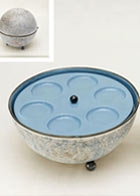Judaica by Design

"Art for art's sake"—the idea that works of art must be judged solely on their own terms, apart from any considerations of moral, religious, or civic value—has by now become largely devoid of meaning, especially as so many artists openly hitch their work to one or another of today's political wagons. But with the lapsing of the polarities to which the phrase once gave rise, in particular those between art and religion, it has also become possible for newer generations of artists to turn their talents unapologetically to religious motifs. The results, as several recent exhibits suggest, are both intriguing and markedly uneven.
Reinventing Ritual, a show from last fall at the Jewish Museum of New York, featured an array of ritual items that simultaneously tried to function independently as objects of conceptual art. The very laboriousness of the effort to bring the two together, epitomized by the abstract categories under which the works were grouped—"Thinking," " Covering," "Absorbing," "Building"—indicates the difficulty many artists still have in capturing the immediacy and God-centeredness of religious ritual from the paralyzing self-consciousness of conceptual art (and, in many cases, contemporary politics).
By contrast, Judaica Twist, which recently opened at Tel Aviv's Beth Hatefutsoth, keeps a steady eye on the purpose of ritual objects, displaying an acute awareness of the need to fuse an object's aesthetic properties with its uses. As one critic noted, the exhibit thereby challenges a previously hardened distinction between "art" and "ritual," with consequences that in many instances are refreshingly well realized. The same may be true of at least the best of the 80 new seder plates shown last year at the Contemporary Jewish Museum of San Francisco.
In the end, of course, the test of new design trends in Judaica will be whether they result in objects that Jews can actually use and learn from, weaving them into the whole fabric of their spiritual and communal lives.
Comments are closed for this article.




